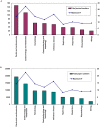The evolution of academic performance in nine subspecialties of internal medicine: an analysis of journal citation reports from 1998 to 2010
- PMID: 23118973
- PMCID: PMC3485187
- DOI: 10.1371/journal.pone.0048290
The evolution of academic performance in nine subspecialties of internal medicine: an analysis of journal citation reports from 1998 to 2010
Abstract
Background: Internal medicine includes several subspecialties. This study aimed to describe change trend of impact factors in different subspecialties of internal medicine during the past 12 years, as well as the developmental differences among each subspecialty, and the possible influencing factors behind these changes and differences.
Methods: Nine subspecialties of internal medicine were chosen for comparison. All data were collected from the Science Citation Index Expanded and Journal Citation Reports database.
Results: (1) Journal numbers in nine subspecialties increased significantly from 1998 to 2010, with an average increment of 80.23%, in which cardiac and cardiovascular system diseases increased 131.2% rank the first; hematology increased 45% rank the least. (2) Impact Factor in subspecialties of infectious disease, cardiac and cardiovascular system diseases, gastroenterology and hepatology, hematology, endocrinology and metabolism increased significantly (p<0.05), in which gastroenterology and hepatology had the largest increase of 65.4%. (3) Journal impact factor of 0-2 had the largest proportion in all subspecialties. Among the journals with high impact factor (IF>6), hematology had the maximum proportion of 10%, nephrology and respiratory system disease had the minimum of 4%. Among the journal with low impact factor (IF<2), journal in nephrology and allergy had the most (60%), while endocrinology and metabolism had the least (40%). There were differences in median number of IF among the different subspecialties (p<0.05), in which endocrinology and metabolism had the highest, nephrology had the lowest. (4) The highest IF had a correlation with journal numbers and total paper numbers in each field.
Conclusion: The IF of internal medicine journals showed an increasingly positive trend, in which gastroenterology and hepatology increase the most. Hematology had more high IF journals. Endocrinology and metabolism had higher average IF. Nephrology remained the lowest position. Numbers of journals and total papers were associated with the highest IF.
Conflict of interest statement
Figures




Similar articles
-
The evolution of academic performance in emergency medicine journals: viewpoint from 2000 to 2009 journal citation reports.Acad Emerg Med. 2011 Aug;18(8):898-904. doi: 10.1111/j.1553-2712.2011.01137.x. Acad Emerg Med. 2011. PMID: 21843226 Review.
-
[A bibliometric investigation to research fronts of major sub-specialties in internal medicine].Zhonghua Nei Ke Za Zhi. 2013 Feb;52(2):144-50. Zhonghua Nei Ke Za Zhi. 2013. PMID: 23967610 Chinese.
-
[An analysis of impact factor of Chinese Journal of Internal Medicine from 2008 to 2010].Zhonghua Nei Ke Za Zhi. 2013 Feb;52(2):133-8. Zhonghua Nei Ke Za Zhi. 2013. PMID: 23967608 Chinese.
-
[Dynamic analysis of the academic influence in Chinese Journal of Hepatology from 2010 to 2016].Zhonghua Gan Zang Bing Za Zhi. 2018 Jun 20;26(6):457-459. doi: 10.3760/cma.j.issn.1007-3418.2018.06.013. Zhonghua Gan Zang Bing Za Zhi. 2018. PMID: 30317761 Chinese.
-
Bradford's law: identification of the core journals for neurosurgery and its subspecialties.J Neurosurg. 2016 Feb;124(2):569-79. doi: 10.3171/2015.3.JNS15149. Epub 2015 Sep 4. J Neurosurg. 2016. PMID: 26339849 Review.
Cited by
-
Poorly cited articles in peer-reviewed cardiovascular journals from 1997 to 2007: analysis of 5-year citation rates.Circulation. 2015 May 19;131(20):1755-62. doi: 10.1161/CIRCULATIONAHA.114.015080. Epub 2015 Mar 26. Circulation. 2015. PMID: 25812573 Free PMC article.
-
Trends in impact factors of ophthalmology journals.Indian J Ophthalmol. 2016 Sep;64(9):668-671. doi: 10.4103/0301-4738.194324. Indian J Ophthalmol. 2016. PMID: 27853016 Free PMC article.
-
The Growth of Poorly Cited Articles in Peer-Reviewed Orthopaedic Journals.Clin Orthop Relat Res. 2019 Jul;477(7):1727-1735. doi: 10.1097/CORR.0000000000000727. Clin Orthop Relat Res. 2019. PMID: 31135548 Free PMC article.
References
-
- Falagas ME, Zouglakis GM, Papastamataki PA (2006) Trends in the impact factor of scientific journals. Mayo Clin Proc 81: 1401–2. - PubMed
-
- Kurmis AP (2003) Understanding the limitations of the journal impact factor. J Bone Joint Surg Am 85: 2449–54. - PubMed
-
- Fitz R (1950) The rise of the practice of internal medicine as a specialty. N Engl J Med 242: 569–74.
-
- Fye WB (1996) American Cardiology: The History of a Specialty and its College. Baltimore: Johns Hopkins University Press.
-
- Cassel CK, Reuben DB (2011) Specialization, Subspecialization, and Subsubspecialization in Internal Medicine. N Engl J Med 364: 1169–1173. - PubMed
Publication types
MeSH terms
Grants and funding
LinkOut - more resources
Full Text Sources
Miscellaneous

